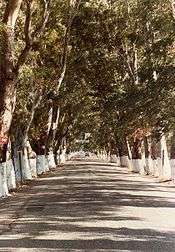Gulf of Gökova

Gulf of Gökova (Turkish: Gökova Körfezi) or Gulf of Kerme (Turkish: Kerme Körfezi, Greek: Κεραμεικός κόλπος, Latin: Ceramicus Sinus, English: Ceramic Gulf or Gulf of Cos), is a long (100 km), narrow gulf of the Aegean Sea between Bodrum Peninsula and Datça Peninsula in south-west Turkey.
Administratively, Gulf of Gökova coastline includes portions of the districts of, clockwise, Bodrum, Milas, Muğla, Ula, Marmaris and Datça. The Greek island of Kos lies along the entry into the Gulf.
Bodrum, located in its northwest reaches, is the only large city on the gulf today. In ancient times, alongside Halicarnassus (modern-day Bodrum), the city of Ceramus, located midway along the gulf's northern shore and after which the gulf was named, was also an important urban center. Across Ceramus (Gereme) (in the modern township of Ören), at a short distance from the gulf's southern shore and not far from its outlying waters, was another historical site of note, called Cedrae in ancient times. Cedrae was located in Sedir Island, which was prized by visitors for its beach and of which some remains still exist.
Etymology
The alluvial plain, also named Gökova, which extends to the Gulf's end, is the location of the townships of Akyaka and Gökova, with only a few kilometers separating the two. These settlements saw their populations considerably increase in recent years, with Akyaka, especially, becoming a rising center of tourism. The municipalities of both of these townships were recently created. They depend upon the town of Ula, which is accessed through Sakar Pass at an altitude of 670 meters and offers an impressive view of the Gulf. Until 1945, the hamlets across the plain, mostly marshlands ridden with malaria until that time, were collectively known as Gökabad. Consequently, the gulf and one of the settlements came to be called Gökova, a term which is often used to designate the area in which Akyaka, and not the neighboring township of Gökova, is actually prominent.
In sum, the name, Gökova, (possibly derived from Cova, the designation by which the area was known in Ottoman times) is mentioned as "Djova" in some recent English navigation charts and alternately is used for the gulf, for the plain at the end of the same gulf, for a township situated in the same plain, and as a casual term covering the emerging resort area centered in the coastal town of Akyaka. The Carian city of Idyma, with acropolis and famed rock tombs, is found at Kozlukuyu, Gökova town, inland from Akyaka. In ancient times, Akyaka was simply a suburb of Kozlukuyu.
See also
| Wikimedia Commons has media related to Ula, Muğla. |
External links
- http://www.gokova.com
- http://www.akyaka.com.tr Akyaka Gökova in English and Turkish
- http://www.gokovabelediyesi.com Gŏkova Town Website with photographs in English, Dutch, French, German and Turkish
- http://e-turkey.net/v/mugla_gokovakorfezi/ Gulf of Gökova with photographs
- http://www.gokovacevre.org The Gökova Environment Group's website in English
- http://www.marmaristown.com/sightseeing/gokova.html Marmaris Sightseeing - Gokova
Coordinates: 36°59′57″N 28°09′43″E / 36.99917°N 28.16194°E